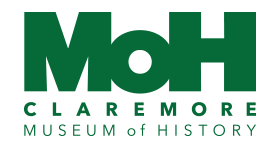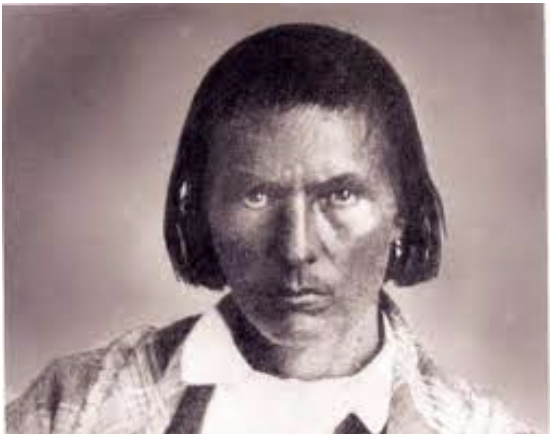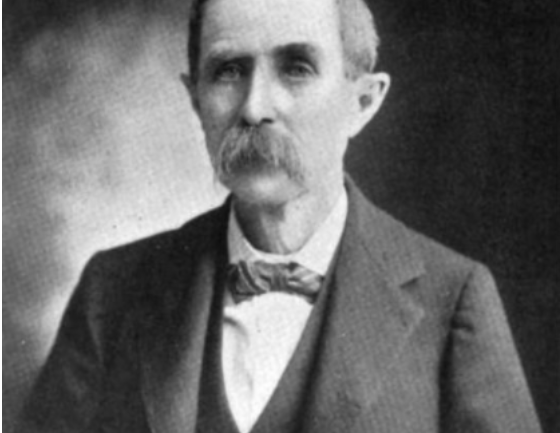Telling the history of Claremore…one story at a time
BLUFORD STARR, PART TWO
Published in the June 1959 Ranchman Magazine, by Myron A. Hurd
When Blue West Starr was foreman of C. W. Turner’s Three Bar Ranch on the south slope of Timbered Ridge north of Inola, he drew a salary of $100.00 per month during the 8 years, and his wife, the former Jessie Adell Hutchins, did the cooking for him, her four children and about 25 cowboys. She drew a salary of $20.00 per month and had a hired girl to help her. Turner furnished groceries and horses, but as was the custom, the cowboys furnished their saddles.
The ranch house was a four room, two-story structure, with a shed kitchen on the side and a bunk house for the men about 100 yards away. There was also a cellar about 12 feet wide and 60 feet long and they used to put beds in it and sleep there when the weather was unusually warm.
Blue Starr started a subscription school in a log house on Timbered Hill in 1895. Pupils were charged $1.00 per head per month. Five-year-old Orange Starr, the youngest of the 12 students attending, really went along to help make up the minimum of 12 required to induce a teacher to hold classes. All 12 children were in the same grade regardless of age, for none of them had ever been to school before. The oldest pupil was Ira Moore of Claremore, who lived 6 or 7 miles north of the school and rode horseback.
In 1898, Blue Starr established his ranch on Scaly Bark Mountain northeast of Inola. He had accumulated a good sized herd of cattle by saving his heifer calves and buying a few extra head for breeding purposes from time to time, another privilege which went with being foreman.
It was also in 1898 that the Starrs moved to Claremore and bought a home on the east side. He hired a contractor to build a huge, 3 story house a mile northeast of Claremore. The same contractor built a similar house a mile south of Claremore for Jim Taylor, later the residence of Henry Kinser.
The Starr’s mansion was completed in time for them to move into it in 1899 and Mrs. Starr went to Kansas City and bought 14 rooms of furniture and shipped it to Claremore. It quickly became the show place and gathering place of the country. It had three fireplaces. The third floor became the children’s play room.
Mrs. Starr entertained beautifully and lavishly, according to Marion Starr Mumford, especially for young people. She entertained the Pocahontas Club in 1900. Among those present were Dr. Emmet Starr and his sisters, Lettie and Mary Bell; Will Rogers; Dr. F. M. Duckworth; Clem, Cora and Will Musgrove; Charley and Sos McClellan; Ida Goodale and Gazelle and Tom Lane; Bess and Juliette Schrimsher; George and Zoe Bullette; Cora Hicks and Josephine Howard, and perhaps others she does not recall.
In 1904, Mrs. Starr chaperoned a group of Cherokee girls to the World’s Fair in St. Louis where they saw Will Rogers, Ted McSpadden and others perform. Blue shipped a trainload of cattle at the same time and met his wife and girls in St. Louis.
When the Starrs moved to Claremore, they attended the old Hiawatha school, which was later demolished. After Blue became a member of the Cherokee Council from Cooweescoowee District in 1899, he persuaded the Cherokee Government to reopen a Cherokee School at Claremore. It opened in 1900 on the Willie Chambers place at the east edge of Claremore. The Starr children and 11 other Indian children attended it tuition free. Later it was moved to the site of the Old Kephart Springs Courthouse, which had been moved to Claremore.
Blue was on the School Board for Cooweescoowee District from 1899 until Statehood in 1907. During part of this time the school was in the Presbyterian Church. Mrs. Starr played an important part in construction of the Presbyterian Church in 1901. The rock was quarried on the Willie Chambers place where Taylor Faulkner now lives.
The Starrs recalled the opening of the Sequoyah Hotel in 1901 and the big ball which was given to celebrate the occasion. The Blue Starrs attended similar balls at Wagoner, Muskogee, Vinita and several in Claremore. The dances were mostly square dances, waltzes and schottisches.
Blue Starr brought 10 head of horses to Claremore from the Three Bar ranch, although he owned 100 or more head. He knew what it was to win as well as to lose on horse races, and at times, the stakes were high. Blue crossed Quarter horses with Spanish mares to get speed and stamina. Dr. Orange Starr thought his father probably had the first Quarter horses in the country.
Blue owned a stallion named Donus. Charley said that one night he crawled out of an upstairs window, slid down a post oak tree, saddled Donus, and rode him six or seven miles to the Hendricks farm south of Tiawah to a country dance. He left the dance about 3 a.m. and was in bed at Claremore when his father called him at 4 a.m. to start milking 40 head of cows. When Blue looked in the barn and saw Donus wringing wet with sweat, he concluded that he was sick, not realizing the hard ride Charley had just given him. Charley and Orange say they kept the bark on that post oak tree worn pretty slick from sliding down it after going up to bed.
The three-story Starr house burned in 1920, and all of the 14 rooms of furniture. The next day, George D. Davis, Claremore banker, told Blue to move into two of his houses. But, Blue said no and moved into his barn until he got the house built. The Starr era and legend did not end with the loss of the Starr’s mansion in 1920. But with the children gone, there was no way of recreating, except in happy memories, the golden years of merry voices of happy children. This unique and original couple…the Blue Starrs…settled down to a quieter and less active life.
William F. Friend, owner of the 7-L Ranch of Vinita, supplies appropriate closing remarks to this story. In recommending Blue West Starr for the Cowboy Hall of Fame in Oklahoma City, he wrote: “I want to mention one ranch boss who ranked 100% in my estimation. Blue Starr spent many years as roundup boss. I have never known any man who could manage a large body of men as fairly and friendly and firmly as Blue Starr, and it was always satisfactory to all concerned. ”He was of the old school and his motto “Do unto others as you would have others do unto you,” and he certainly lived up to it.”
“Friend concludes, “and in memory and respect to Blue Starr, I must say that to my knowledge, he never violated or misused the confidence and respect placed in him by such a large group of good men.”
Note: Blue Starr, Sr. came to the Indian Territory from Georgia twenty years before the “Trail of Tears” and was known as a Western Cherokee. His son, Blue Starr II’s Cherokee’s name was Yona, and he was of the Wolf Clan.
According to the Rogers County History book, in 1954 Jim Hammett, Mayor of Claremore, honored Blue Starr II by naming a street for him. He was noted for his honesty and integrity.



